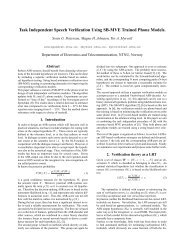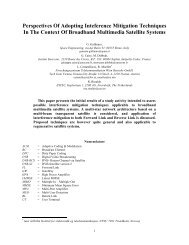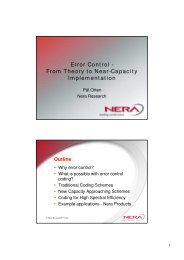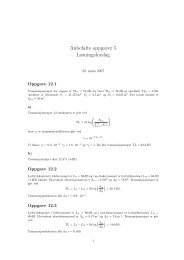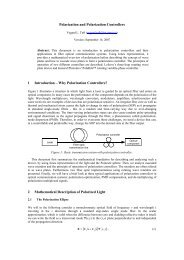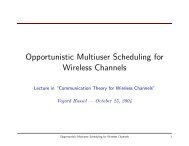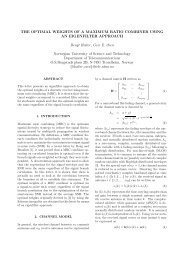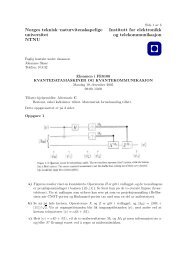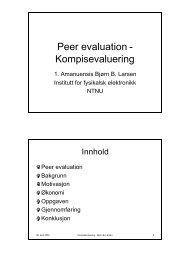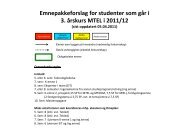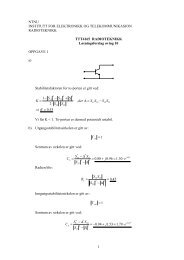Lab 4 Laser - Institutt for elektronikk og telekommunikasjon - NTNU
Lab 4 Laser - Institutt for elektronikk og telekommunikasjon - NTNU
Lab 4 Laser - Institutt for elektronikk og telekommunikasjon - NTNU
Create successful ePaper yourself
Turn your PDF publications into a flip-book with our unique Google optimized e-Paper software.
1.2 <strong>Laser</strong> fundamentals 7<br />
1.2 <strong>Laser</strong> fundamentals<br />
1.2.1 Light amplification<br />
Atoms and molecules interact with light in three different processes:<br />
Absorption, spontaneous emission and stimulated emission.<br />
- Absorption: An atom or molecule can capture, ”absorb”, a photon of<br />
light and be excited, converted to a higher energy level. The photon<br />
must have a specific frequency n to provide the proper amount of energy<br />
E = hν to excite the atom or molecule. This process called ”stimulated<br />
absorption” is the atom’s response to electromagnetic stimulation by the<br />
incoming photon. Stimulated absorption is responsible <strong>for</strong> the colors of<br />
dyes, which absorb light of specific frequencies, while a black or gray object<br />
absorbs all frequencies equally..<br />
- Spontaneous emission:An excited atom or molecule with excess stored<br />
energy E can release that energy spontaneously, by emission of a photon<br />
with frequency ν = E/h Spontaneous emission is responsible <strong>for</strong> the light<br />
emission by fires, fireflies, fluorescent paint, sunlight, LEDs, hot pokers,<br />
and most types of lamps.<br />
- Stimulated emission: An excited atom or molecule can be stimulated<br />
to release excess energy E in response to an incident photon of the exactly<br />
the right frequency (ν = E/h) and simultaneously release, or emit, two<br />
photons with the same frequency, using the energy of the incident photon<br />
plus the stored energy of the excited atom. Stimulated emission is the<br />
process that provides optical amplification in most lasers, since one photon<br />
in produces two photons out, an amplification factor of exactly two per<br />
event.<br />
Real atomic and molecular systems absorb or emit light at many discrete<br />
frequencies, each with a range, or bandwidth D ν centered around the main<br />
frequency ν = E/h. Optical amplification occurs when the rate of stimulated<br />
emission exceeds the rate of (stimulated) absorption, producing gain G where<br />
G =<br />
light out<br />
light in . (1.1)<br />
Amplification (G > 1) occurs in an atomic or molecular system with a population<br />
inversion, which means that the number of excited atoms (or molecules)<br />
exceeds the number of unexcited atoms or molecules. This means that there<br />
will be more stimulated emission than stimulated absorption.



